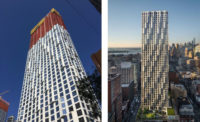Parachute into Dubai, the glittering chimera, for an architectural smorgasbord. Since the 1970s, the little city on the waterfront of the Persian Gulf has boomed into a unique, tower-inflected phenomenon, corresponding to the vision of its ruler, Sheikh Mohammed bin Rashid Al Maktoum.

What does it add up to? For an architect, Dubai has become a required stop on the 21st-century version of the grand tour—a place to balance the firm’s portfolio of domestic work, to compete for a job, or to gawk. Imagine a totally new city (though a small trading center existed before), springing up in the desert, filled with a gaggle of skyscraping monoliths, artificial islands offshore, the world’s tallest building, the world’s largest mall, the most luxurious … seemingly everything. For architects during the past decade, the future possibilities have seemed endless.
Endless, but thin. Structurally, Dubai operates off a single strip development like Las Vegas, called Sheikh Zayed Road. Drive far enough away at an angle, and the city seems precariously and narrowly poised. Recently, however, the city has been adding infrastructure by widening the original highway, adding an elevated tram that will link the extremities this fall (and, unfortunately, block the adjacent buildings), and incorporating tunnels and connecting roads with ease. The strip is widening and fattening up.
Changes allowing foreign ownership of real estate in 2002 fueled growth, and towers bloomed as a result. Few individual structures, however, warrant admiration. While thoughtful or experimental tall buildings can be spotted among the clusters of spires and cranes, it is the aggregate of 40- to 60-story buildings, not the specific examples, that attracts our attention: How did they do it?
Urbanistically, the city is making attempts to densify, constructing whole neighborhoods of related functions at a stroke, such as the emerging financial district, or the luxury housing and hotel complex that surrounds the new Dubai Mall. Low-scale luxury housing often apes a vaguely Moroccan effect, rather like Disney’s Epcot World Showcase. The artificial islands, such as Palm Jumeirah, which have received a bountiful share of media attention, combine housing and resorts, like the newly opened Atlantis, offering supposed security and exclusivity.
One stunning exception to the pack literally stands out—the Burj Dubai. Developed by Emaar properties, designed by the Chicago office of SOM with a team that included architect Adrian Smith, FAIA, when he was still with SOM, and still involves structural engineer and partner William Baker, the tower displays the insistent elegance of a large needle plunged into the sand. It also remarkably echoes another vision hailing from Chicago, Frank Lloyd Wright’s mile-high tower called The Illinois.
According to Baker, the building differs from Wright’s in several key aspects. While Wright’s tower, a tripod, would have been filled with its own infrastructure, the Dubai wonder spirals up from a base constructed of three petals that provide maximum stability to the wind loads that would have caused Wright’s to oscillate. The solution, which will not be completed until September 2009, rises to an unparalleled height—some sources currently list 2,684 feet, though the client and its agents and related professionals are sworn to silence. That Burj building alone, which may represent some kind of metaphorical topping out—of an era’s optimism and unbridled extremes—is worth the flight. SOM and Emaar have realized what is possibly the world’s most elegant, as well as tallest building—spare, using a minimum of mass, structurally tight, and architecturally evocative.
At present, the flights from Dubai International Airport are outbound. When world markets slowed, the pace of design screeched to a halt in Dubai, an emirate now subject to the vagaries of world markets. This publication and others have reported mass layoffs at the international architectural firms stationed there, as mega-towers disappeared into an economic sandstorm. Every other major tower, meant to rival the Burj, has been placed “on hold,” as has The Waterfront, the major new city masterplanned by Rotterdam-based OMA. The gossip around the watering holes tells of young employees, inexperienced with a recession, who, burdened with mortgages and leases and auto loans, are driving to the airport, leaving their keys in their cars, and flying home. Bye-bye Dubai.
Official statistics of the state of the real estate economy remain obscure: why would any developer, particularly such a closely guarded one, need to tell anyone? But a drive through Marina City presents a spectral face, as scores of buildings remain totally empty (though sometimes “sold-out”), and merchants in the shops surrounding them complain of little or no traffic. Cars can easily roll along Sheikh Zayed Road, normally at a congealed standstill.
Built on oil, or the products that oil provides, Dubai has become dependent on others—including the worldwide lust for more and better real estate that characterized the recent past—for its future. Dead quiet from a design perspective at present, the city is riding the sine curve of the world economy, which will rise again. When it does, what will Dubai do next?
If you wish to write to our editor-in-chief you can email him rivy@mcgraw-hill.com.

